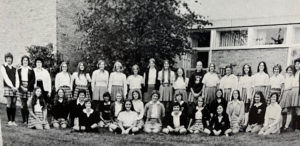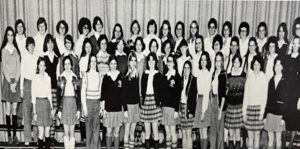by Nancy Stratman, NDA Archivist
For over a century, Notre Dame Academy has embraced the tradition of a uniform dress policy, fostering a sense of unity and identity among its students. From the early days of the blue uniform dress to the iconic grey skirts that NDA students proudly wear today, the attire has evolved while preserving its essence. In this captivating installment of the Academy Archives, Notre Dame Academy’s Archivist, Nancy Stratman, takes us back in time to explore the timeless fashion and the treasured uniform traditions that have shaped Notre Dame Academy students for the past 100 years.
By September of 1921, the enrollment at Notre Dame Academy stood at an all-time high of just over 200 students. The collection of buildings that encompassed the grade school and both divisions of the high school on Fifth Street underwent a major renovation of all rooms to accommodate the increased enrollment. In conjunction with the updated facilities, two school uniforms were adopted for all students attending the scientific and commercial courses.
“I lived on the 43-acre farm where St. Barbara’s Church now stands. My first year at Notre Dame, I boarded the 6 a.m. commuter at Devon, Kentucky, a mile from my home, got off in Erlanger, then took a jitney bus (fare 5 cents) to the end of the Fort Mitchell car line, a street car to Covington, and arrived at Notre Dame Academy about 7 a.m. I was just a scared little 13-year-old country kid in my 14-inch from the floor uniform, dark blue serge with a white collar, NDA insignia on the sleeve, who was so proud to be a student at Notre Dame School of Commerce in 1922.” (Clara Wulfeck Garnett, 1924)
After several variations of a school uniform were attempted, a consensus on design and material was established by the fall of 1926. For all students, the school uniform now included a winter uniform consisting of a blue uniform “dress”comprised of a full-pleated, serge skirt of navy blue, a blouse or jacket of the same color, a Windsor tie of navy blue and a detachable Buster Brown white collar and white cuffs. That same year, a summer uniform was introduced to be worn during the hotter and more humid months of the year and included a navy-blue pleated skirt, a white pongee, smock-styled long-sleeve blouse and a one-half inch dark blue tie. It was affectionately referred to as the “middy”, because it resembled the shirt worn by naval academy midshipmen.
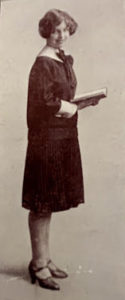
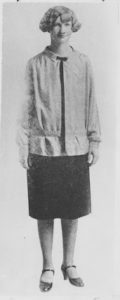
Both the winter and summer uniforms required black flats or 1” heels, with neutral colored hose or tights. During the late 1920s, the winter uniform was amended to include any navy-blue skirt and complimentary top as long as the white collar and cuffs fit.
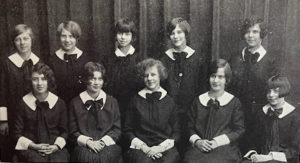
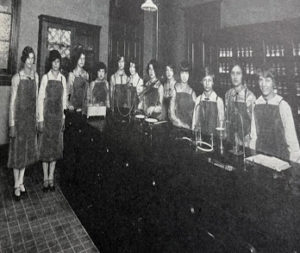
RIGHT: Junior chemistry students with leather aprons over their summer uniforms. (The Gavel, May 1928)
The primary reason for adopting a uniform dress code was to eliminate any form of dress competition. After five years of implementation, although most parents liked the idea of a uniform from a cost basis, it seems that the students themselves needed a few other reasons to fully embrace the idea. The inaugural issue of The Gavel (October 1926) featured two editorials written by upperclasswomen who appealed to the students to embrace the idea of a mandatory uniform, not from cost benefit, but from more of a spirit-filled and symbolic perspective.
“Our uniform – what does it signify? What does it symbolize? Is it merely a dress, a garment to be worn regularly to class? Our uniform symbolizes simplicity and modesty of dress as well as discipline…Notre Dame Academy requests that her students appear in uniform on all school days of the year. For she realizes that it is not only necessary to teach her pupils the fundamentals of English, mathematics and Latin, but also modesty, obedience and loyalty, which are the really important virtues in life. We understand her motive and correspond by wearing our regulation dress with pride on all class days. We are proud to be seen in our regulation dress, because it shows that we are from Notre Dame and that we cherish a wholehearted interest in our Alma Mater, in her teachings and her rules. It is a manifestation of the school spirit that has ever characterized Notre Dame Academy. Oh, fellow students, let us wear our uniform as we do our refinement, wear it and think what it symbolizes and always be proud of our uniform.” (Excerpts from The Gavel, October 1926, written by senior Esther Bramlage)
“Almost all large organizations have adopted a uniform. The army has its khaki, the sailors don their navy blue and so each society of note has its distinguished dress that is worn by individual members on all occasions. Notre Dame Academy, as a large institution, requests her students to appear in uniform on all school days of the year. Our uniform is simple, modest and stylish, carrying out the wishes of the Holy Father in regard to dress. A great advantage derived from the wearing of a uniform is the elimination of dress competition. (Excerpts from The Gavel, Oct 1926 written by junior Elizabeth Vonderheide)
Gym Uniform, circa 1920s-early 1940s
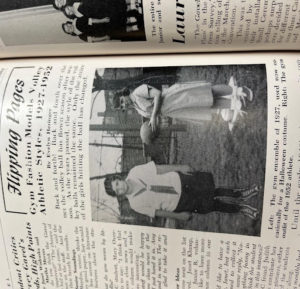
Not only was there now a required uniform to wear during the school day, but a uniform was also adopted for participants in the physical education classes. The uniform included: knee length black poplin bloomers, a white Indian-shear cotton blouse gathered at the bottom with elastic and full-length black hose. The uniform provided ease of movement for exercising, while adhering to the dictates of modesty, as the black hose had to meet with the bloomers right above the knee.
When asked to reminisce about their days at NDA, most graduates from the 1920s through the 1940s, remembered and commented the most about the black bloomer and white top gym uniform.
“Which one of us in the class of 1939 could ever forget our gym class experience as sophomores? Dressed in our glamorous black bloomers, white middies, lisle hose and high-top canvas shoes – we stopped traffic on 5th Street and caused hysteria to the neighborhood when we trooped out in response to a state fire drill. How mortified we were as we weren’t exactly thrilled with the dress code of the hour.” (Clare Lutkenhoff Effler,1939)
“Our stylish gym outfits of black bloomers and white middy blouse, and the bloomers had to come down your knees and meet your stockings – no bare legs could ever be shown!” (Mary Gastrich Duve, 1940)
“The funniest memories are those of gym class in our outlandish big black bloomers that fit below the knee with those long hose”! (Sr. Mary Philip, SND (Rose Regina Trauth),1941)
“Our gym uniforms were awful. We were always getting into trouble for pulling our gym bloomers up above our knees. (that was considered sinful!)” (Ann Osterman Lamia, 1942)
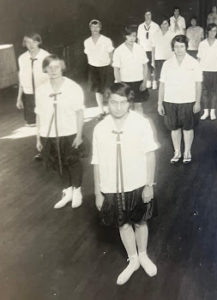
1928-29
By 1928, the old blue serge skirt of the summer uniform was a thing of the past. In its stead an airy pongee dress, consisting of a loose-fitting smock and slip, had been adopted by the incoming students. Each uniform was complemented with a different colored Windsor tie with loop knots which distinguished one class from another. The freshmen wore green, the sophomores wore crimson, the juniors wore coral and the seniors wore brown. (The Gavel, October 1928)
“We had winter and summer school uniforms. Our summer uniform was made out of a material called pongee. They gave us a pattern and we bought the pongee. Everybody sewed back then; we made it at home. This is what I thought was neat: the freshman wore green ties, the sophomores wore red, the juniors wore coral and the seniors wore brown. So, you would always know what grade the student was in. In wintertime, we had navy blue uniforms with stiff cuffs – we had to starch them, collar and cuffs.” (Bettie Tuemler Moser, 1934)
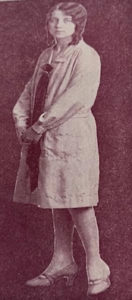 .
. 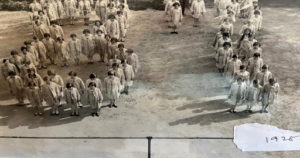
RIGHT: Sophomore Class in summer uniforms, 1928
May,1930
High school students of Notre Dame Academy appeared in a celebratory cap and cape for the first time at the closing of May Devotion on May 28th and then again at the May 1930 commencement ceremonies. The three-quarter length cape, featuring the school colors, was blue satin lined in gold. The cap was blue, piped in gold and topped by a gold tassel. The ensemble was to be won at all formal assemblies.

ABOVE: Students model the uniform dress, cap and cape of the 1940s during a student council celebration of NDA during the 1970s
For the 1930-31 academic year, a more stylized uniform was adopted for special occasions, which included a one-piece navy-blue dress with a belted waist and decorative buttons down the bodice and two front and back pleats. A white NDA monogrammed patch was displayed on the left bodice. Required footwear included nylon hose and 1” pumps. This new uniform gave a more formal look and was worn with the blue and gold honor capes and caps on special occasions.
Several alums from the time commented about the blue and gold honor uniforms in the NDA Alumnae Recollection booklet:
“We felt so proud when we would march in our uniforms with our blue and gold capes and caps” (Anna Mae Muders Clark, 1935),
“For the celebration of the Immaculate Conception Feast, we had a novena of preparation. The wearing of the Cap and Cape for the occasion made it very special.” (Sr. Mary Thaddeus, SND 1938)
“The special celebrations (Christ the King, Immaculate Conception, etc.) when we wore our gold caps and blue capes was especially nice.” (Mary Gastrich Duve, 1940).
“The wearing of the blue and gold capes and caps always added to the solemnity of the celebrations.” (Sr. M. Rose Paula (Jean) Foltz, SND, 1947)
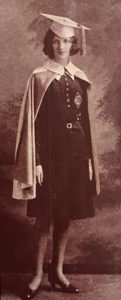
1940s
Due to the increased costs of fabric during the war years, the blue uniform dress was modified, and students were allowed to wear any style of dress as long as they adhered to a basic overall look. The dresses had to be navy blue with a white collar and cuffs and the skirt length had to reach to the knees. There were no restrictions on buttoned bodices or belted waistlines.
A small blue patch with the letters NDA in white was required to be worn on the left bodice. The requirements for footwear also were loosened to include white anklets and either penny loafers or saddle shoes. At the start of the 1945 academic year, the NDA monogram was changed to a blue patch, outlined in white and a larger NDA in white. According to The Gavel, “Notre Damians were made happy on September 7th when envelopes appeared on each desk in the classrooms. The envelope contained a new monogram patch for each student’s uniform. The emblem is arranged the same as before, but the edges are finished in white stitching instead of blue, a fact which makes the monogram more distinguished looking, much to the liking of all students.” (The Gavel, October 1945, picture showing a variety of uniform dresses and both old and new monograms)
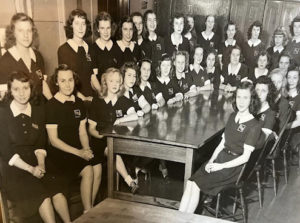
Gym Uniform 1940s-early 1960s
The 1940s also saw a change in the gym uniforms required for each student. The black bloomers and white top were replaced with a one-piece dress with a set-in waist, zippered top, shorter sleeves, a flared skirt and attached panties underneath. The outfits came in two colors: black or seafoam green and were completed with white anklets and Keds.
The gym outfit also doubled for the team uniform for the volleyball team. (as seen in the picture below, The Gavel, 1946) Reactions to the new gym uniform were mixed according to the following alumnae recollections.
“We were the first class to wear the outfits with a zipper for gym. Before that they had the big bloomers and white middy. Our class got the green, with the panties under the skirt, the top was pleated, and it had a zipper front and a little collar. We thought we were so sharp because we had those fancy little outfits. We still had to change outside the gym in the hallway. We all had a chair and we put our bag and all of our clothes on it.” (Rose Marie Hanneken O’Brien, 1946)
The green gym suits with those horrible bloomers! Ugly black shoes with shoestrings!” (Pat Schnell Pope, 1957)
“The horrible green gym suits passed down for 12 generations!” (Daphne Dorsel Lloyd,1958)
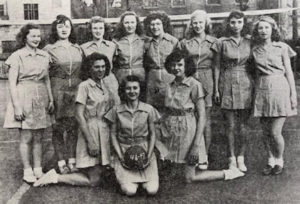
1953
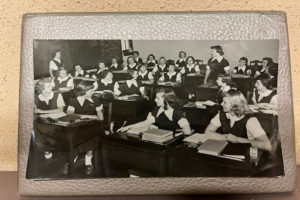
With the start of the new school year in September of 1953, a new uniform was introduced and required for all incoming freshmen. The new design was necessary due to the inability of the manufacturer to secure the pattern from previous years. “The new ensemble consists of a navy blue, four-pleated jumper with cut-aways under each arm and a V-neck, which emphasizes the white, broadcloth blouse with turned-backed cuffs and a Peter Pan collar. The new uniform is touched off with an NDA pin occupying the place which was formerly held by the monogram.” (The Gavel, Oct 1953). The outfit was completed with white anklets and dark leather (not suede) oxford shoes. A light-weight navy blue cardigan sweater or a navy-blue bolero (which matched the jumper) could also be worn in cold weather. However, no costumed jewelry or any other accessory that detracted from the tailored style of the uniform was permitted. The complete uniform was to be worn on all regular class days as well as to and from school.
From the appearance of the first uniforms in the early 1920s until the early 1960s, the navy-blue uniform was synonymous with the academic, spiritual and moral discipline required by the Sisters of Notre Dame for all of their students at the 5th Street campus. Unfortunately, even the most stringent of uniform policies could not keep economic disparities from surfacing.
“Wearing a uniform kept the students at the same income level to a certain degree. But, by the end of freshman year, it was not difficult to distinguish students from poor, middle class or high-income families. The girls from higher incomes had salon hairstyles and time for extracurricular activities because it was not necessary for them to work part-time after school.” (Mary Martha Seifert Kaiser, 1959) Nevertheless, concentrating on academic success and preparedness for their futures, instead of focusing on economic differences between students, became a hallmark of a NDA education. The simple, modest yet stylish uniform encouraged students to see the similarities of their classmates rather than the differences, building a bond of sisterhood that, for many, would last a lifetime.
1963-1965
The 1962-63 academic year became the year to say goodbye to so many traditions and memories of the 5th street campus, but also served as a bridge year to life as it would be on the new campus. One very visible sign of changes to come was the introduction of a new uniform for incoming freshmen. While current sophomores, juniors and seniors continued to wear the traditional navy-blue jumper, freshmen sported a new uniform which consisted of a white blouse and a charcoal grey pleated skirt.

A charcoal grey blazer accented with silver buttons and a silver uniform pin, were required for formal gatherings, but not required for everyday classroom use. No sweaters could be worn with the uniform or in place of the blazer. The uniform was completed with white anklets or clear hose and black shoes and were required to be worn to and from school. No Keds or gym shoes could be worn at any time except during Physical Education classes.
As stated in the 1962-63 Student Handbook, “students will wear the prescribed uniform on all class days and for all school functions except when express permission is given to be out of uniform.” This was the first time in the NDA dress code that “out of uniform” days would be allowed.
Even with the changes from a uniform dress/jumper to a separate skirt and blouse, the administration at NDA strove to keep the uniform simple, modest and affordable; eschewing current fads and fashion trends. School leadership felt that the simple uniform promoted a visual unity of purpose for the educational standards expected of their students. Although there would be many alterations to the original blouse and skirt uniform combo from the 1960s until the present day, this new uniform in 1962 would mark the beginning of the iconic grey uniform skirt, which has now become synonymous with the modern-day Notre Dame Academy student.
Gym uniforms (mid-1960s-1979)
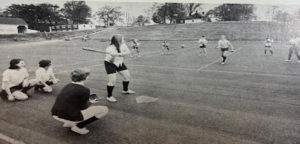
Along with a new school uniform, the move to the new campus also introduced a new gym uniform. Gone were the green and black gym dresses of yesteryear, replaced by a simple combination of navy bermuda shorts, a white cotton button-down blouse, white anklets or knee socks and gym shoes. The gym uniform was required to be kept in the new lockers provided in changing rooms unless it had been taken home to be laundered.
ABOVE: (late 1960’s-1970s, gym class playing softball in parking lot)
1965-1970
By 1965, student dissatisfaction with the heavy grey skirt and blazer prompted a new uniform change, which featured a cleaner, more modern look and a lighter weight, washable fabric, which was easier to take care of. The new school uniform consisted of a simple, pleated light grey skirt, a white blouse and a navy-blue uniform cardigan sweater. The silver NDA crest (pin) was to be worn on the sweater. Grey or navy-blue knee socks, plain hose or white anklets were a required part of the uniform as well as solid colored, low-cut shoes. No “electric colors”, Keds or gym shoes were permitted.
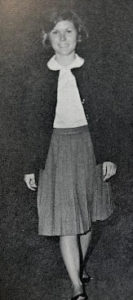
For assemblies and special events, students were required to wear the grey skirt, an “assembly” blouse, plain hose and black flats. The assembly blouse was a white, long-sleeved blouse featuring a ruffle down the front of the blouse and at the cuffs.
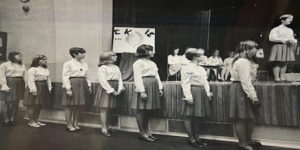
A navy-blue blazer with the NDA crest was also available for purchase, but not required and could only be worn for special events, not in the classroom.

ABOVE: Student council officers in grey skirt, white blouse and navy blazer with emblem (The Gavel, 1967-68)
By 1967, the silver crest had been replaced by name badges, required for all students and faculty.
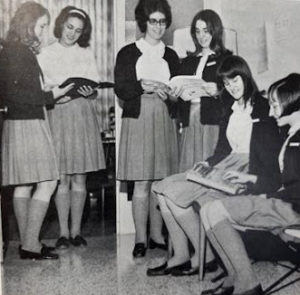
1970s
During the early 1970s, the uniform code was revised to allow for a few choices within the basic uniform offerings. The light grey skirts were offered in two different styles: one with a fully pleated skirt and another which was straighter with 2 kick pleats in front. However, as noted in the student handbook, “A rolled skirt is NOT uniform. The skirt must be a reasonable length at all time.” (NDA Student Handbook, 1973-74) The blouse could be any button-down style, long or short sleeve, as long as it had a collar and was tucked into the skirt waist band at all times. No assembly blouses were required. Restrictions were also lifted on the type of sweater allowed: “Any solid colored white, blue or grey sweater, any style, may be worn. A blouse must be worn under the sweater. Sweatshirts and jackets are not acceptable.” (NDA Student Handbook, 1973-74).
Neutral colored hose or solid navy, grey or white knee socks were still required. Any type of shoes were permitted except Keds, track or tennis shoes. From many alumnae comments it is evident that most students adhered to the dress code policy during school hours, but once the school day ended, skirts were rolled up, blouses were pulled out and knee socks were rolled down.
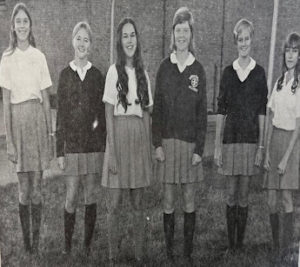
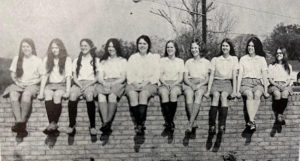
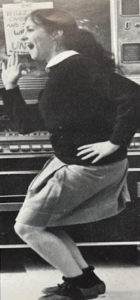
1971 1972 1973
In the Fall of 1973, a poll was taken of NDA students to get their opinion on various aspects of student life at Notre Dame Academy. The first question concerned the possible changes in uniforms in the next ten years. Jenny Daniels, junior, predicted that the “length will go down as prices go up”. Tara Sommerkamp, junior, thought that “we will be able to wear whatever we want”. Lisa Foltz, sophomore, was also optimistic. “The uniforms in the future will probably be pant suits or a different style of skirt.” (The Gavel, November,1973)
Starting with the 1974-75 academic year, due to a shortage in the uniform skirt materials, a new plaid skirt was introduced for all incoming freshmen and new students. Current students could opt to stay with the grey skirts or purchase a new plaid skirt.
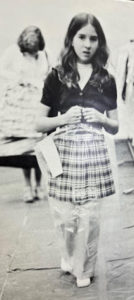 .
. 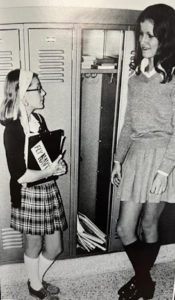
LEFT: freshmen getting her new plaid (Tapestry, 1974-75)
RIGHT: senior big sister and freshman little sister compare uniform skirt at orientation, (Tapestry, 1974-75)
ABOVE: The Gavel editorial staff, Tapestry( 1974-75)
Starting with the academic year 1975-76, regulations for socks and sweaters were loosened to include “some form of hosiery must be worn at all times” instead of the historic grey, navy blue or white and “sweaters are open to color and imagination, provided that they appear over a white blouse and are not turtle-necked” instead of the regulation navy blue.
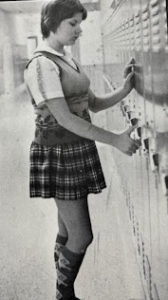
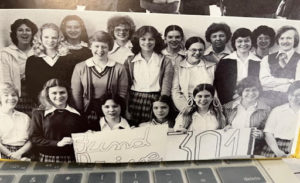
Sr. Mary Marlene, administrator, said that individuality was one of the reasons given for the change. “It lets the girls be a little different”, she stated. “But they still should be neat and orderly”. Principal Sr. Mary Virginia Ann also expressed that the change would “add a little color to the whole atmosphere.” But both Sisters agreed that a regulated uniform was still a good idea.
“Economically, it makes it a lot easier on the parents and the girls. All the parents back it up”, Sr. Marlene stated. “To tell you the truth”, she added, “I think the girls like it too.” “It does make deciding what to wear a lot less complicated”, one junior stated. “But, personally, I’d rather wear blue jeans.” Although Notre Dame Academy student apparel is far from the casual look of jeans, the sock and sweater change has provided some girls with greater dressing freedoms. (The Gavel, September 1975)
Beginning with the 1975-76 academic year, a major change to the uniform policy was made when grey dress slacks were introduced as part of the dress code. Now the students had the option to wear either the grey skirt, plaid skirt or grey dress slacks.
ABOVE: 1977-78 choral club
However, by the end of the 1977 academic year, a debate was raging over the loosening of regulations regarding the uniform policy at Notre Dame Academy. Two different views on the effectiveness can be seen in the article below published in The Gavel.
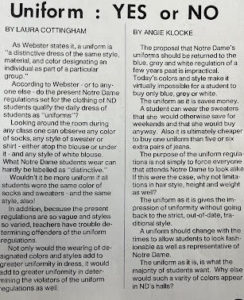
ABOVE: The Gavel, May, 1977
1980s and 1990s
By the beginning of the 1980-81 school year the winds of change had begun to blow. The loosening of the dress code, which had provided opportunities for more individuality, was gone and a simple, more conservative dress code was once again adopted: the plaid skirt option was out, and incoming students were once again required to wear the regulation light grey skirt or slacks with more traditional accessories.
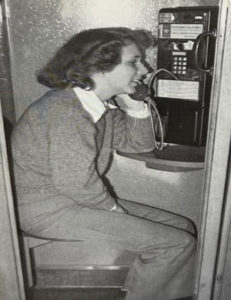
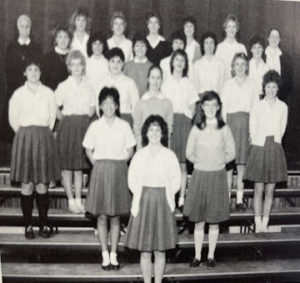
According to the student handbook, “Students must be orderly and clean in appearance and well-groomed at all times. The standard uniform consists of a grey uniform skirt or grey uniform slacks, and a standard white school blouse, not of knitted material. The blouse must be tucked in during the school day. The blouse should be buttoned with the exception of the top button. The student may also choose to wear a grey, white or navy-blue knitted sweater (cardigan or pullover) over the blouse. Hosiery is limited to grey, white or navy-blue knee socks or white anklets. Students have a choice of either wearing loafers or casual tie oxford shoes during the school day. Tennis shoes are required for physical education classes.”
By the end of the 1980s, the only dress code regulation that was relaxed, seemed to be the knee-hi socks, which could now be worn rolled down during the school day and tennis shoes were permitted as appropriate footwear.

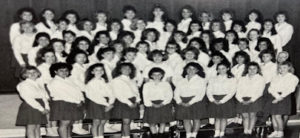
Between 1990 and 2003, although the basic dress code retained its simplicity, a few changes were made to allow for more accessory choices. The grey skirt or slacks and the white button-down blouse remained as the basis of the uniform policy. A white t-shirt could now be worn under the blouse for warmth, but then the top button of the blouse had to be buttoned so that the t-shirt did not show. In addition to the traditional pullover or cardigan sweater, an NDA sweatshirt or a plain grey, white or navy-blue sweatshirt, was now permitted to be worn over the blouse. And of course, seniors had the privilege of wearing their senior class sweatshirts to class in lieu of a regulation school sweatshirt. Also, in addition to the regulation knee socks or anklets, uniform leg warmers of solid navy-blue, white or grey are permitted. Perhaps the biggest change in the uniform during this time period was the addition of navy-blue walking shorts which were permitted to be worn in place of the skirt or slacks during the months of August, September, May and June.
 .
. 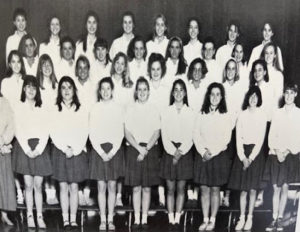
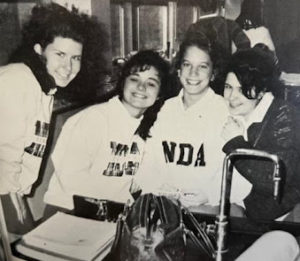
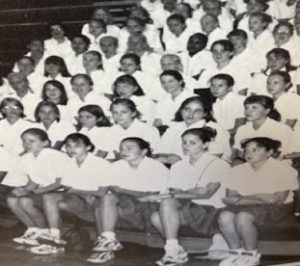
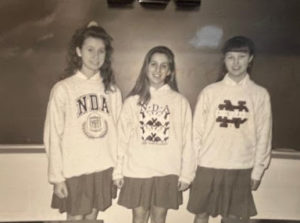
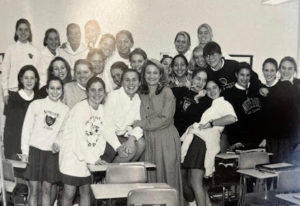
2003 – 2013
During the 2000s, Notre Dame Academy would undergo several internal and external structural changes: most notable, a new administrative governance model was implemented to include a president/principal leadership team and two major building renovations. On October 19, 2003, Notre Dame Academy celebrated the 40th anniversary of the move to the Hilton Drive campus. And, just as in 1963, changes to the school uniform were implemented for the 2003-04 academic year. The use of grey dress slacks instead of the grey skirt would no longer be permitted. The “blouse-out” era was coming to an end as the student life committee decided to phase out the button-down white uniform blouses and instead allow a white knitted shirt with a banded waist. This was mandated for all in-coming freshmen and would also be available for upperclasswomen. Also, the practice of “dress-down” and “dress-up” days was formalized and implemented.


ABOVE: Students 2003-04 and 2010-11
With only a few minor changes and additions, the NDA uniform policy has continued as a simple, conservative dress code throughout the 2000s until the present day. According to the Student/Parent Handbooks of 2003/04 and 2010/11 the uniform policy featured four main components: a grey uniform skirt that must be zippered and buttoned, whose length should be no more than 3 inches above the knee, and which was not to be rolled at the waist; a white NDA banded shirt (a student could wear a t-shirt under the uniform shirt, but it had to a be plain white, V-neck t-shirt and could not be visible at the collar or below the NDA school shirt); white socks; and appropriate shoes that had a back on them. Optional items that could be worn with the uniform included the standard navy-blue NDA pullover sweater or the navy-blue NDA sweatshirt. No other sweatshirts or sweaters were acceptable (seniors still retained the privilege of wearing their senior sweatshirts). No slacks could be worn under the uniform during the school day; however, grey leggings could be worn if purchased from Schoolbelles.
In addition to the basic school uniform requirements, in 2003 the handbook addressed the issue of body art for the first time with the following statements: “Visible body piercing, except at the ear, and visible tattoos are prohibited at school. Extreme unnatural hair coloring is not permitted.” (Student/Parent Handbook, 2003-04)
For the first time, the issue of “dress up days” and “dress down days” was addressed.
There may be occasions throughout the school year when the students may “dress up” for the day. The dress code for those days include black dress slacks, white blouse or white shirt with sleeves which must cover the band of the slacks and may not be low cut and shoes with a back. There may be occasions throughout the school year when the students may “dress down” for the day. Attire permitted on these days includes jeans, sweatpants, wind pants or capris; a shirt, with sleeves that covers the stomach area and is not low-cut and shoes with a back on them. Students may not wear clothing that contains inappropriate writing. (Student/Parent Handbook, 2003-04)
For the 2010-2011 academic year, the “dress down” dress code was amended to allow NDA spirit wear, but no spirit wear from other schools.
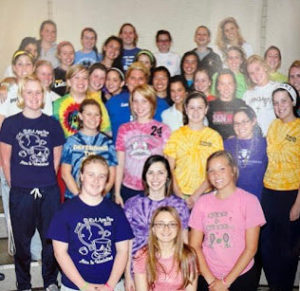
2012-2023
By the Fall of 2012, the simple uniform code of a white top, grey skirt, white socks and appropriate footwear (with minor additions and changes) was the norm, but some felt that the student body might have become “too comfortable” with the dress code. White banded tops had become somewhat worn, clean but dingy and many sported the remnant colors of a class project. Skirts, which had presented a pristine look that fit fine for the freshman year had accumulated small rips and tears, stains, broken zippers, and pinned together hemlines and button enclosures by senior year. Visible waistbands disappeared with the discontinued button-down blouses and the students quickly realized that the banded top neatly hid many a “rolled-up” waistband. It seemed obvious that some of the student body had lost the importance of and understanding behind the uniform policy. Therefore, in every Student/Parent handbook from 2012 onward, not only was the basic uniform policy and exceptions/additions stated each year, but the following overview statement detailing the purpose and goals of the uniform policy was added.
All students at Notre Dame Academy are required to wear a school uniform which emphasizes a traditional dress code. The code is intended to:
– encourage cleanliness, neatness and pride in one’s appearance
– foster respect for the way in which one presents herself to others
– create a semi-formal atmosphere needed for a disciplined learning environment
– provide a uniform manner of dressing which minimizes social differences that may exist among students.
By choosing to be a student at Notre Dame Academy, this code becomes the student’s responsibility and it is her responsibility to know the spirit of NDA’s dress code and to be in compliance with that dress code while on school property. The cleanliness, length and neatness of the uniform skirt and uniform top reflect a student’s commitment of respect for self and others. (2012-2013 Student/Parent Handbook)
In 2015, a more detailed description of skirt maintenance was added to the dress code:
“The grey uniform skirt must fit properly, be zippered and buttoned, hemmed appropriately and free of stains, rips and/or holes. It may not be rolled at the waist and may be no more than three inches above the knee. Students are required to obtain a new skirt if it no longer zips, has tears, holes or stains.”
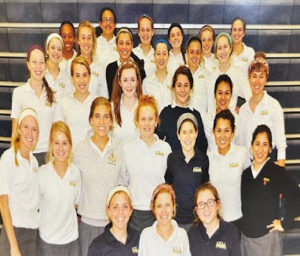
During the ensuing years, the uniform policy has remained very similar to the guidelines issued in 2012. Notre Dame Academy’s school uniform consisted of a grey uniform skirt, which must be zippered and buttoned, not be rolled at the waist and no more than 3 inches above the knee; a white NDA banded shirt and solid white, grey, black or navy socks and appropriate shoes that have a back on them. Optional items that can be worn with the uniform include a navy-blue NDA pullover sweater, a navy-blue NDA sweatshirt, a navy-blue NDA fleece (added in 2016) and grey, black or blue leggings. Also available in 2014 was a navy-blue blazer with NDA’s emblem for special occasions such as Mass, award ceremonies, etc. In 2013 seniors were given the opportunity to purchase a navy banded shirt; however this was replaced in 2015 with a light blue banded shirt, which then became available for all students.
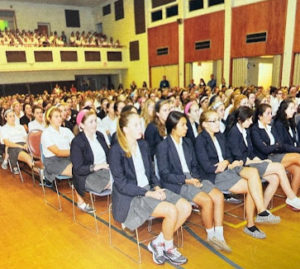 .
. 
2014 2016 seniors
During the past few years the only significant change in the dress code has been the addition of identification lanyards for security purposes and the institution of Spirit Wear Fridays. Currently every Friday is an NDA spirit wear day. Students may wear spirit wear tops along with the grey uniform skirt. If a “spirit wear” sweatshirt is worn, a t-shirt or blouse must be worn underneath. Only NDA spirit wear is acceptable. Spirit wear Fridays are not permitted on exam days or any other time that administration may deem necessary.
 .
. 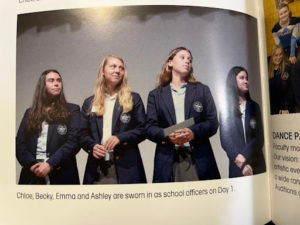
2019 2019-20 school officers
 .
. 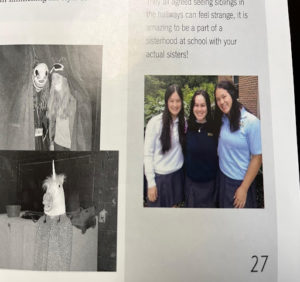
2021-22 seniors 2021-22 siblings
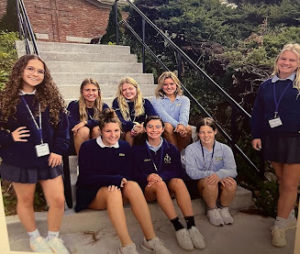 .
. 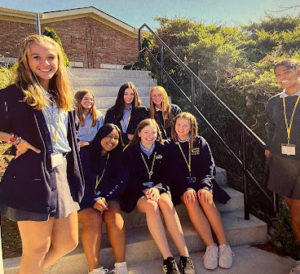
2021-22 sophomores 2021-22 juniors
As you can see, for the past 100 years, Notre Dame Academy has steadily adhered to a more conservative dress code, expanded at times to meet the flexibility of the current age, but consistent in the basic requirements of cleanliness, neatness and modesty, which helped to minimize the social and economic differences of students. From its simplest form of a blue skirt and top to the many options available in the current policy, Notre Dame Academy has always stood for consistency in policy and adherence to the rules that make the Notre Dame Academy difference.
2022-23 Dress Policy
All students at Notre Dame Academy are required to wear a school uniform, which emphasizes a traditional dress code. This code is intended to: encourage cleanliness, neatness and pride in one’s appearance; foster respect for the way in which one presents herself to others; create a semi-formal atmosphere needed for a disciplined learning environment and provide a uniform manner of dressing which minimizes social differences that may exist among students. By choosing to be a student at Notre Dame Academy, this code becomes the student’s responsibility, and it is her responsibility to know the spirit of NDA’s dress code and to be in compliance with that dress code while on school property. The cleanliness, length and neatness of the uniform skirt and uniform top reflect this pride. Students should rarely be out of uniform during the school day. Any exception requires a note from the parents and a permit from the school office to be presented to each teacher.
Notre Dame Academy has a school uniform that consists of:
- a grey uniform skirt or uniform slacks (the skirt or pants must fit properly, be zipped and buttoned, hemmed appropriately and free of stains, rips, and/or holes). Students are required to obtain a new skirt or pants if it no longer zips, has tears, holes, or stains.
- a white or light blue banded Notre Dame Academy polo shirt
- solid white, grey, black or navy-blue socks
- appropriate shoes that have a back to them
- nametag/lanyard
Optional items that may be purchased and worn with the uniform include:
- a navy-blue Notre Dame Academy pullover sweater
- a navy-blue Notre Dame Academy cardigan sweater
- a navy-blue Notre Dame sweater vest
- a navy-blue Notre Dame Academy sweatshirt (available for purchase through Schoolbelles and NDA’s Bambootique)
- a navy-blue Notre Dame Academy fleece
- a navy-blue blazer with NDA’s emblem for special occasions such as Mass, award ceremonies, etc.
- grey, black, or navy-blue leggings
- black dress slacks for designated events
Students are expected to be in uniform throughout the school day and to wear the uniform skirt zipped and buttoned. It may not be rolled at the waist and may be no more than three inches above the knee. NDA encourages parents to check how the uniform fits at the beginning of each school year and to purchase a new one if necessary. Schoolbelles is NDA’s official uniform provider.
No colored undergarments or undergarments with visible writing that detracts from the uniform may be worn under the uniform blouse. If a student chooses to wear a t-shirt under the uniform shirt, it must be a plain white V-neck and may not be visible. No slacks may be worn under the uniform during the school day. Students may wear the uniform sweater, sweatshirt or fleece during the school day. No other sweaters or sweatshirts are acceptable.
Freshmen are required to purchase uniform gym shorts from Schoolbelles or NDA’s Bambootique. An appropriate t-shirt is to be worn with the shorts.
Any visible body piercing, except the ear, and visible tattoos are prohibited at school. Extreme unnatural hair coloring is not permitted.
Purses and backpacks must be able to fit under desks.
Dress Down Days
There may be occasions throughout the school year when the students may “dress down” for the day. These opportunities include, but are not limited to, out of uniform days, field trips, retreats, etc. Attire permitted on these days may include:
- jeans, sweatpants, wind pants, capris or gym shorts
- a shirt with sleeves, that covers the stomach area and is not low cut
- shoes with a back to them
Students may not wear clothing that contains inappropriate writing or pictures or politically charged clothing. Students who continue to violate dress down day guidelines, may lose the privilege of participating in a dress down occasion.
Dress Up Days
There may be occasions throughout the school year when the students may “dress up” for the day. Students are expected to dress appropriately and follow attire guidelines given for the event. Students who dress inappropriately may be asked to change into a uniform (see additional guidelines below).
Special Occasions
Students sometimes have the opportunity to dress up for events such as Silver Bells, Junior/Senior Prom, Mother/Daughter and Father/Daughter dances, special senior events and theatrical performances. At these times it is expected that students dress in a way that is acceptable for young women attending a Catholic high school. This includes appropriate dress or skirt length and coverage of the stomach, back and chest areas.
Spirit Wear Fridays
Every Friday is an NDA spirit wear day. Students may wear spirit wear tops along with the grey uniform skirt or pants. If a “spirit wear” sweatshirt is worn, a tee shirt or blouse must be worn underneath. Spirit Wear Fridays are not permitted on exam days or any other time that administration may deem necessary.





